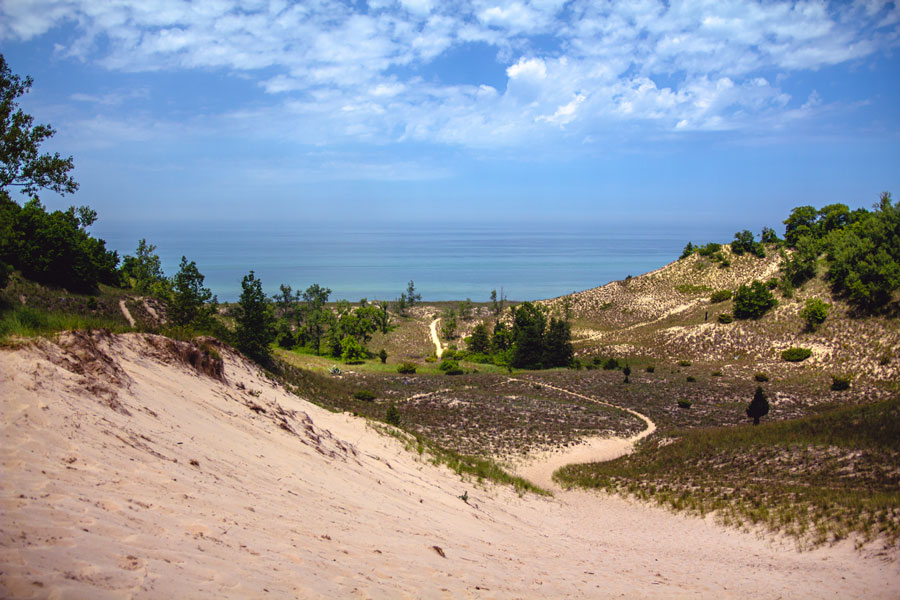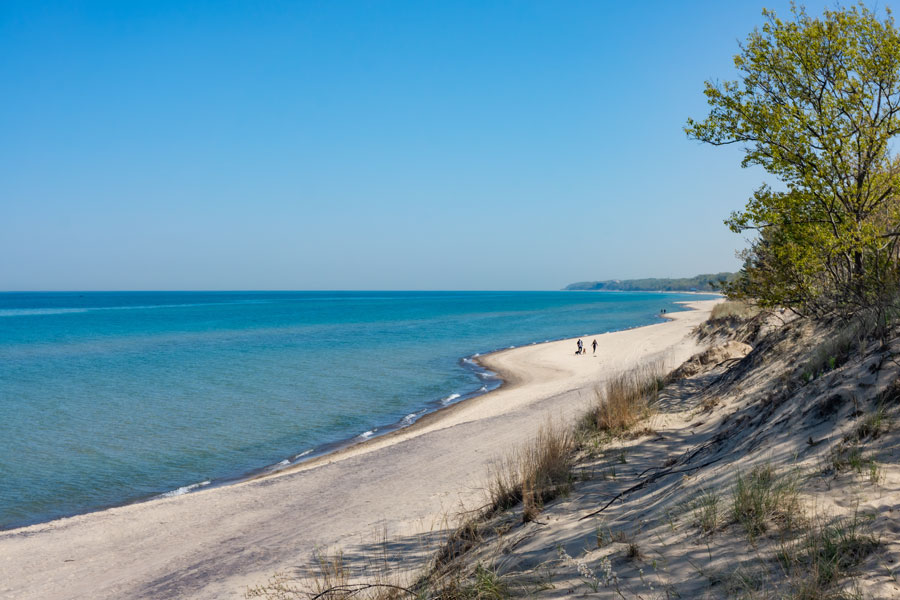Indiana Dunes National Park

Indiana Dunes National Park is located in northwestern Indiana and is managed by the National Park Service; it was first authorized as the Indiana Dunes National Lakeshore by Congress in 1966, but later re-designated as the nation’s 61st national park on February 15, 2019.
The park, which has about two million visits a year, is situated along the southern shore of Lake Michigan, and runs approximately 20 miles in length, covering 15,349 acres and boasting 50 miles of trails over rugged dunes, mysterious wetlands, sunny prairies, meandering rivers and peaceful forests.
There are many opportunities for recreation in Indiana Dunes, including 15 miles of beaches, camping at the Dunewood Campground – with all sites featuring grills, a picnic table, and access to restrooms with running water and showers – in addition to cycling, hiking, fishing, swimming, horseback riding, and cross-country skiing. Rangers also provide free walks and talks throughout the park on a regular basis.
Indiana Dunes has numerous short hike trails and a few longer distance trails, including the Paul H. Douglas Trail, Tolleston Dune, Succession Trail, Bailly-Chellberg Trails – a series of interconnected trails – Cowles Bog Trail, the Calumet Dune Trail, and the Glenwood Dune Horse and Hiking Trail, among others.
Indiana Dunes has over 369 species of flowering plants, with some of the most common being the May apple, buttercups, violets, orchids, and goldenrod.
Indiana Dunes National Park is also home to a wide variety of wildlife, including white-tailed deer, red fox, raccoons, opossums, cottontail rabbits, various rodents, Canada geese, gulls, squirrels, hawks, turkey vultures, mallards, great blue herons, songbirds, and garter snakes. There are also 350 species of birds, making the park an ideal location for bird-watchers.
Indiana Dunes includes habitats for several rare plants and animals. Of the park’s many species of plants, at least two of them – Mead’s Milkweed and Pitcher’s Thistle – are included on the Federal list of Threatened and Endangered Species. In addition, federally threatened and endangered wildlife who call the park home include the Indiana bat, Eastern massasauga rattlesnake, Rufa Red knot, and Piping plover; the park is also a suitable habitat for the American bald eagle.
Among the natural habitats of Indiana Dunes are:
- Calumet Prairie, located in the northern region of the park.
- Cowles Bog – a National Natural Landmark named after biologist and ecologist Henry Chandler Cowles – is a wetland complex containing bog, fen, marsh, swamp, wet meadow, and pond habitats.
- The Great Marsh, a wetland overlooking Lake Michigan.
- The heron rookery, a hardwood forest.
- Hobart Prairie Grove, an area of forested ravines.
- Hoosier Prairie, also a National Natural Landmark, is a 430-acre tallgrass prairie.
- Mount Baldy is a 123-foot sand dune located at the east end of the park.
- Pinhook Bog, another National Natural Landmark, is an acidic bog that is home to pitcher plants and other wetland species
The creeks and rivers of the national park include
- Dunes Creek is a 4.3 mile-long stream which passes through the coastal sand dunes to empty into Lake Michigan.
- East Arm Little Calumet River, also known as the “East Branch Little Calumet River”, is a 22.1 mile-long portion of the Little Calumet River that begins just east of Holmesville, Indiana.
- Salt Creek is a 24 mile-long tributary of the East Arm Little Calumet River that begins south of Valparaiso in Porter County, Indiana, and flows north until it joins the East Arm Little Calumet River.
- Trail Creek is a 7.3 mile-long stream whose main stem begins at the juncture of the West Branch Trail Creek and the East Branch Trail Creek in LaPorte County, Indiana.
There are also a number of historic areas in the park, several of which are listed on the National Register of Historic Places. These include Bailly Homestead, a pioneer trading post established in 1822; Bailly Cemetery, which saw its first burial in 1827; Century of Progress Architectural District, five buildings originally built for the 1933 Century of Progress World’s Fair; and the upcoming Swedish Farmsteads Historic District, representative of communities in the area originally settled by Swedes.
The park also features a number of educational programs and public facilities.
Indiana Dunes National Park
1215 N State Rd 49
Porter, IN 46304
(219) 395-1882
https://www.indianadunes.com





